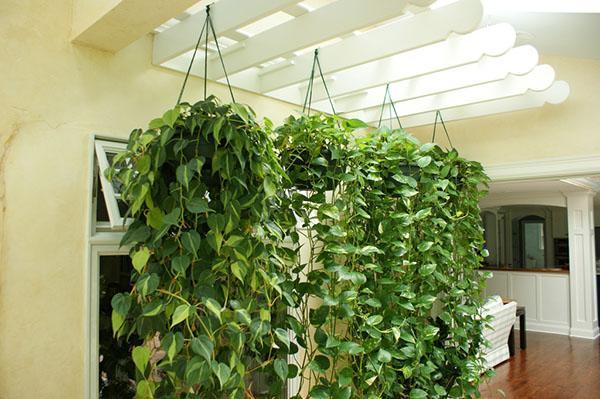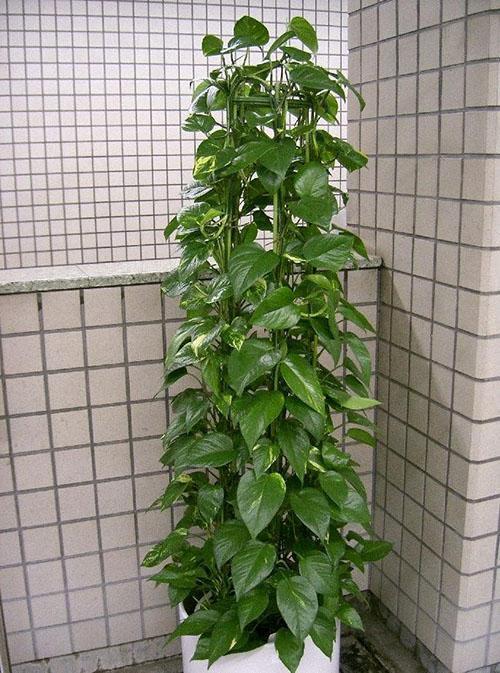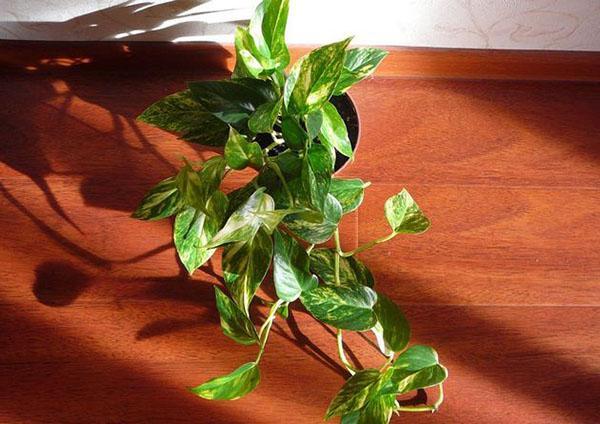Liana scindapsus - interior decoration
 In the wild, scindapsus is a semi-epiphyte liana that climbs a tree trunk to a height of more than 10 meters. The plant has two types of roots: aerial and fibrous underground. In Sri Lanka, local residents are fighting a powerful vine that occupies too much of the territory. At home, scindapsus is grown in floor pots, providing the plant with a trellis, or in hanging pots. The attention of gardeners is attracted by the motley or bright green foliage, unpretentious care. Under natural conditions, scidapsus blooms with a small inflorescence, but under indoor conditions there is practically no chance to see flowering.
In the wild, scindapsus is a semi-epiphyte liana that climbs a tree trunk to a height of more than 10 meters. The plant has two types of roots: aerial and fibrous underground. In Sri Lanka, local residents are fighting a powerful vine that occupies too much of the territory. At home, scindapsus is grown in floor pots, providing the plant with a trellis, or in hanging pots. The attention of gardeners is attracted by the motley or bright green foliage, unpretentious care. Under natural conditions, scidapsus blooms with a small inflorescence, but under indoor conditions there is practically no chance to see flowering.
Care rules

In insufficient light, the scindapsus reacts with abundant foliage.
When caring for a plant, you must observe the watering regime. Moderate moistening of the soil after it dries to more than 1 cm in depth will provide the root system of the scindapsus with comfortable conditions for development. Abundant and frequent watering will lead to root rot and death of the flower. It makes no sense to create special conditions for keeping the plant, increasing the humidity in the room. It is enough to periodically wipe the leaves with a damp cloth or spray from a spray bottle. In the summer, you can do a warm shower, which will have a beneficial effect on the condition of the flower.
In winter, the scindapsus should not be placed next to heating devices.
The shoots of the plant grow very quickly. In just one year, the branches of the flower will become almost 40 cm longer. The formation of the crown is as follows:
- Pruning stems and their further use for propagation.
- Pinching of growth points of stems to stimulate the formation of side shoots and increase branching.
- Installation of an arch for securing long stems or a special pipe with sphagnum inside. Moss is moistened, which allows the aerial roots to receive additional moisture.
When caring for the scindapsus, do not forget to fertilize the plant with complex fertilizers. During the period of active growth, watering should be carried out twice a month with the addition of fertilizer in liquid form. In winter, it is enough to feed the plant once a month.
Transplanting and soil selection rules
 Transplant young scindapsus once a year at the end of February. Adult flowers try to disturb less. It is enough to change the pot every 2-3 years. If you take a not too deep, but wide pot, you can create a beautiful composition of scindapsus of different varieties or arrange a lush bush from an old plant and rooted cuttings.
Transplant young scindapsus once a year at the end of February. Adult flowers try to disturb less. It is enough to change the pot every 2-3 years. If you take a not too deep, but wide pot, you can create a beautiful composition of scindapsus of different varieties or arrange a lush bush from an old plant and rooted cuttings.
For self-preparation of soil, use in equal proportions:
- river sand;
- humus;
- peat or leafy ground;
- expanded clay or perlite.
Scindapsus needs a good drainage layer.
To create a beautiful bush, you must first trim the shoots and root the cuttings in water. For an old plant, it is imperative to inspect the root system and remove damaged roots.
Reproduction of scindapsus
 You really like your plant and want to see a few more specimens nearby. You can buy, or you can propagate a bush that is already growing. Pruning an adult scindapsus makes it possible not only to give it a beautiful shape, but also to get cuttings. Use clean scissors or a knife for cutting. Make a cut under the knot. For successful rooting, the cut shoot should have three leaves. You will need a jar of water and a well-lit place.
You really like your plant and want to see a few more specimens nearby. You can buy, or you can propagate a bush that is already growing. Pruning an adult scindapsus makes it possible not only to give it a beautiful shape, but also to get cuttings. Use clean scissors or a knife for cutting. Make a cut under the knot. For successful rooting, the cut shoot should have three leaves. You will need a jar of water and a well-lit place.
 You can immediately plant the stalk in the ground, having previously processed the cut with a rooting tool. To achieve the desired result, cover the pot with the handle with a transparent bag or plastic bottle. After a maximum of 3 weeks, the rooted scindapsus can be transplanted to a permanent place of residence.
You can immediately plant the stalk in the ground, having previously processed the cut with a rooting tool. To achieve the desired result, cover the pot with the handle with a transparent bag or plastic bottle. After a maximum of 3 weeks, the rooted scindapsus can be transplanted to a permanent place of residence.
 If you press the layers to the ground, it will soon give roots. After a while, the first leaves will appear. Carefully detach the young plant from the mother liquor and transplant.
If you press the layers to the ground, it will soon give roots. After a while, the first leaves will appear. Carefully detach the young plant from the mother liquor and transplant.
Having cut off a long shoot, carefully divide it into several parts. Each must have leaves. This approach allows you to get several cuttings at once.
Diseases and pests
 Improper care of the scindapsus can lead to its diseases:
Improper care of the scindapsus can lead to its diseases:
- Leaves turn yellow. The reason is that the plant needs fertilization.
- The tips of the leaf plates dry out. The reason - the plant is placed too close to the heating device, lack of spraying.
- The foliage is falling. The reason is that the liana does not have enough power and light, perhaps there are drafts.
- The stems are rotting. The reason is the low temperature of the content and excessive soil moisture.
- Change in leaf color and the appearance of white spots. The reason is an excess of lighting or a lack of it.
Of the pests of scindapsus, spider mites are most often annoyed, aphid, thrips. It is enough to carry out the processing with actellik to defeat them.
About the rules for caring for scindapsus - video